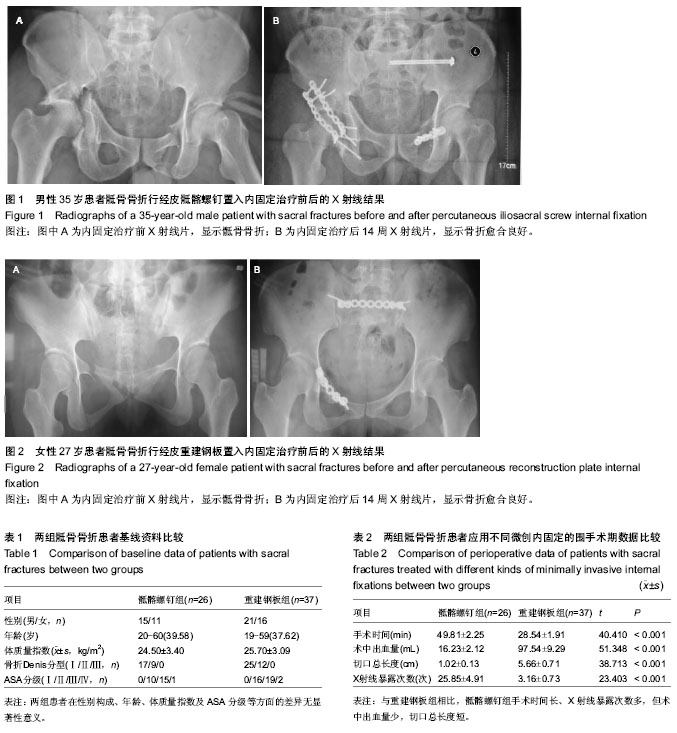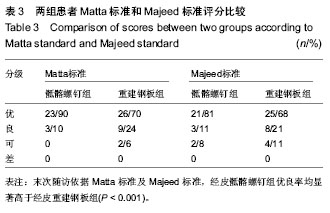| [1] Roy-Camille R, Saillant G, Gagna G, et al. Transverse fracture of the upper sacrum. Suicidal jumper's fracture. Spine(Phila Pa 1976). 1985;10(9):838-845.
[2] 蔡军辉,王伟良,张力成.骶骨纵形骨折的治疗进展[J].中华创伤骨科杂志,2011,13(9):881-884.
[3] Mehta S, Auerbach JD, Born CT, et al. Sacral fractures. J Am Acad Orthop Surg. 2006;14(12):656-665.
[4] 陈爱民,李永川, 赵良瑜,等.骨盆后环不稳定伴骶丛损伤的诊断和治疗[J].中华骨科杂志,2012,28(6):516-519.
[5] 贾健,胡永成,张铁良,等. 骶骨骨折的诊治现状[J].中华骨科杂志, 2009,29(12):1168-1176.
[6] 陈明,谢鸣,勘武生,等. 不稳定型骨盆骨折的手术方式探讨[J]. 中华创伤骨科杂志,2013,15(5):445-447.
[7] 蔡军辉,王伟良,张力成.骶骨纵形骨折的治疗进展[J].中华创伤骨科杂志,2011,13(9):881-884.
[8] Schildhauer TA, Chapman JR, Mayo KA.Multisegmental open sacral fracture due to impalement: a case report. Orthop Trauma. 2005;19(2):134-139.
[9] Denis F, Davis S, Comfort T. Sacral fractures:an important problem. Retrospective analysis of 236 cases. Clin Orthop Relat Res. 1988;(227):67-81.
[10] Schmidek HH,Smith DA,Kristiansen TK. Sacral fractures. Neurosurgery. 1984;15(5):735-746.
[11] 王雷,柳超,田纪伟.腰骨盆重建术治疗不稳定骶骨骨折[J].中华创伤杂志,2013,29(7):619-623.
[12] 胡旭栋,向宁,王光林,等.三角固定技术治疗Tile C型骨盆骨折[J]. 中华创伤骨科杂志,2012,14(5):399-404.
[13] 王奇,黄其杉,王向阳,等.骶骨后路钉板固定的解剖学研究[J].中华骨科杂志,2010,30(3):277-281.
[14] Tonetti J. Management of recent unstable fractures of the pelvic ring. An update Conference supported by the Club Bassin Cotyle. (Pelvis-Acetabulum Club). Orthop Traumatol Surg Res. 2013;99(1):S77-86.
[15] Park YS, Baek SW, Kim HS, et al. Management of sacral fractures associated with spinal or pelvic ring injury. J Trauma Acute Care Surg. 2012;73(1): 239-242.
[16] 赵艳.螺钉与钢板在骨盆骨折置入内固定应用中的生物力学评价[J].中国组织工程研究与临床康复,2011,15(48):9070-9073.
[17] 肖丹,柯雨洪,王义生.经皮骶髂关节空心螺钉置入联合骨盆外固定架治疗C型骨盆骨折48例:回顾性病例对照[J].中国组织工程研究与临床康复,2009,13(43):8560-8563.
[18] Matta JM, Tornetta P 3rd. Internal fixation of unstable pelvic ring injuries. Clin Orthop Relat Res. 1996;(329):129-140.
[19] Majeed SA. Grading the outcome of pelvic fractures. J Bone Joint Surg. 1989;71(2):304-306.
[20] Tan GQ, He JL, Fu BS, et al. Lumbopelvic fixation for multiplanar sacral fractures with spinopelvic instability. Injury. 2012;43(8):1318-1325.
[21] Dudda M,Hoffmann M,Schildhauer TA. Sacrum fractures and lumbopelvic instabilities in pelvic ring injuries:Classification and biomechanical aspects. Unfallchirurg. 2013;116(11):972-978.
[22] Hoskins J, Lewis PB., Smith S, et al. Diagnosis and Management of Sacral Fractures. Contemp Spine Surg. 2011; 12(9): 1-8.
[23] Ge Z, Wang B, Zhang D, et al. Effect of iliolumbar fixation in patients with Tile C pelvic injury and analysis of relative factors. Zhongguo Xiu Fu Chong Jian Wai Ke Za Zhi. 2012; 26(11):1285-1290.
[24] Mendel T,Noser H,Kuervers J,et al. The influence of sacral morphology on the existence of secure S1 and S2 transverse bone corridors for iliosacroiliac screw fixation. Injury. 2013; 44(12):1773-1779.
[25] Miller AN, Routt ML.Variations in Sacral Morphology and Implications for Iliosacral Screw Fixation. J Am Acad Orthop Surg. 2012;20(1):8-16.
[26] Osterhoff G,Ossendorf C,Wanner GA,et al. Percutaneous iliosacral screw fixation in S1 and S2 for posterior pelvic ring injuries: technique and perioperative complications. Arch Orthop Trauma Surg. 2011;131(6):809-813.
[27] Reilly MC,Bono CM,Litkouhi B,et al.The effect of sacral fracture malreduction on the safe placement of iliosacral screws.Orthop Trauma. 2003;17(2):88-94.
[28] Bodzay T,Szita J,Mano S,et al. Biomechanical comparison of two stabilization techniques for unstable sacral fractures. J Orthop Sci.2012;17(5):574-579.
[29] Padalkar P,Pereira BP,Kathare A,et al. Trans-iliosacral plating for vertically unstable fractures of sacral spine associated with spinopelvic dissociation: A cadaveric study. Indian J Orthop. 2012;46(3):274-278.
[30] Suzuki T,Hak DJ,Ziran BH,et al. Outcome and complications of posterior transiliac plating for vertically unstable sacral fractures. Injury. 2009;40(4):405-409.
[31] König MA, Seidel U, Heini P,et al. Minimal-invasive Percutaneous Reduction and Transsacral Screw Fixation for U-shaped Fractures. J Spinal Disord Tech. 2013;26(1):48-54.
[32] Koenig MA,Jehan S,Boszczyk AA,et al. Surgical management of U-shaped sacral fractures: a systematic review of current treatment strategies. Eur Spine J. 2012;21(5):829-836.
[33] König MA, Seidel U, Heini P, et al. Minimal-invasive Percutaneous Reduction and Transsacral Screw Fixation for U-shaped Fractures. J Spinal Disord Tech. 2013;26(1):48-54.
[34] 王国栋,周东生.骶骨多平面骨折的治疗现状[J].中华创伤骨科杂志,2012,14(7):621-623.
[35] Matta JM, Yerasimides JG. Table-skeletal fixation as an adjunct to pelvic ring reduction.Orthop Trauma. 2007; 21(9): 647-656.
[36] Ruatti S,Kerschbaumer G,Gay E,et al. Technique for reduction and percutaneous fixation of U- and H-shaped sacral fractures. Orthop Traumatol Surg Res.2013;99(5): 625-629.
[37] Schweitzer D,Zylberberg A,Cordova M,et al. Closed reduction and iliosacral percutaneous fixation of unstable pelvic ring fractures. Injury. 2008;39(8):869-874.
[38] Chen HW,Liu GD,Ou S,et al. Treatment of unstable sacral fractures with percutaneous reconstruction plate internal fixation. Acta Cir Bras. 2012;27(5):338-342.
[39] Coste C,Asloum Y,Marcheix PS,et al. Percutaneous iliosacral screw fixation in unstable pelvic ring lesions: The interest of O-ARM CT-guided navigation. Orthop Traumatol Surg Res. 2013;99(4):S273-278. |

